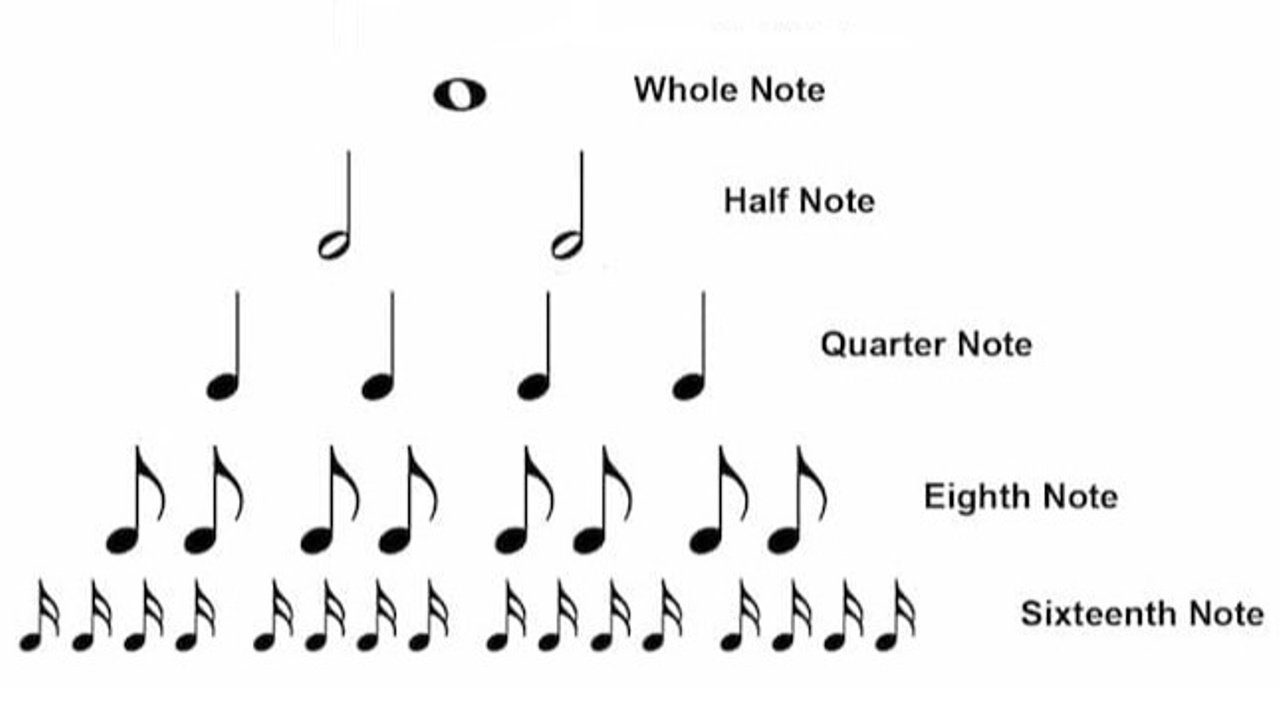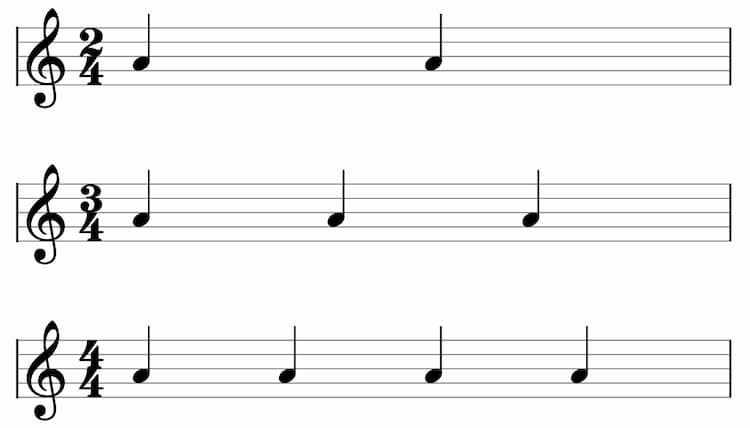What is a Time Signature in Music?

In western music time signatures are the foundation for expressing rhythm. They give musicians the necessary information to know how many beats fit inside a measure of music, and don’t worry if those two terms are new to you - you’ll understand them by the end of this article.
It’s important to first understand that the rhythm of a melody, or any musical idea, is not dictated by the time signature - it just lives within it, meaning there are an almost infinite number of rhythmic ideas that can fit inside a time signature, for example:
90% of the music you hear on the radio will be in the time signature ‘4/4’ (aka common time) yet there’s a lot of variation in how all those songs feel rhythmically, right?
Why do we need a time signature?
Time signatures in music are essential for measuring and organizing musical sections; it gives us a start point, an end point, and tells us what can go in between.
Without time signatures, all musical notation relating to rhythm would be useless, it would be like writing a sentence without spaces or punctuation… itmakesitmuchmoredifficulttoknowwhatsgoingon.
Parts of a Time Signature
If you’ve ever seen a piece of sheet music, you’ll have seen two numbers right after the clef (𝄞), they sort of look like a fraction - which is fairly close to what a time signature symbol is!
It can seem daunting at first, but there are really only two elements you need to understand; the top number, and the bottom number.
What does the bottom number in a time signature mean?
The bottom number gives us the value of one beat/note (aka the beat unit), for example;
- Half note (minim) = /2
- Quarter note (crochet) = /4
- Eighth note (quaver) = /8
- Sixteenth note (semiquaver) = /16
Below is a diagram of the notation to express these values. We can also see how each note can be evenly divided into 2 - these are known as ‘subdivisions’. Every group of notes in the diagram (2 half notes, 4 quarter notes, etc) is equal in length to the whole note.

Below we see the duration of notes inside one measure of 4/4 - 1 whole note takes up the entire measure, whereas it takes 8 eighth notes to take up the same length of time.

“But there’s no reference point! How long is a quarter note or a sixteenth note?”
The actual length of time a note lasts is set by the speed or ‘tempo’ - a term you should already be familiar with.
What does the top number in a time signature mean?
The top number of the time signature indicates how many beats (or notes) go into one bar (or measure).
The diagram below shows how many beat units (in this case, quarter notes) fit in a measure depending on the top number.
4/4= 4 Quarter notes, 2/4 = 2 Quarter notes, 3/4 = 3 Quarter notes etc.

Types of Time Signatures
There are different categories of time signatures, some will seem quite straightforward, while others may take a little more time to get comfortable with.
The basic principles remain the same, it’s just that certain types of time signatures are more common and so may feel more natural as you’re already familiar with them.
Time Signatures for Simple Meter
Simple meter is when the top number of the time signature can be broken into smaller groups of two notes, eg:
- 2 quarter notes can be divided into 4 eighth notes
- 3 quarter notes can be divided into 6 eighth notes
- 4 quarter notes can be divided into 8 eighth notes
Let’s take a look at examples of time signatures with some stave diagrams. Each diagram contains two measures, they are seperated by a bar line going through middle.
Even if you don’t read music, you will still benefit from looking at these - being able to visualize the subdivision of notes will help you better understand this principle.
2/4 Time Signature Diagram
Two beats per measure, this time signature naturally lends itself to a ‘left-right, left-right’ feel - good for marching music.

3/4 Time Signature Diagram
Sometimes referred to as simple triple meter, this time signature is often associated with waltz music but is also used in many other styles and genres.

4/4 Time Signature Diagram
Also known as common time music, this is by far the most popular time signature in western music.

Time Signatures for Compound Meter
With compound meter, the top number in the time signature represents a subdivision of a dotted note.
What is a dotted note?
A dotted note means we increase the note length by half as much again.
So if a quarter note is equal to 2 eighth notes, we take half of that (which is 1 eighth note) and add it on top. Now we have 3 eighth notes in total, which equals 1 dotted quarter note.
This means that a dotted note divides into groups of three instead of two, thus we need to use compound meter to express the subdivisions.
Another way to think about compound meter would be*:

6/8 Time Signature Diagram
Below we can clearly see how the 2 dotted notes divide into 6 eighth notes (two groups of three).
When you look at the groups of three try counting out loud, and accent/emphasize the 1 and the 4 to hear the triplet groove, like this:
“One Two Three Four Five Six”
Do you hear how that has a different feel compared to the straight ‘One Two Three Four’ of 4/4 simple meter?

9/8 Time Signature Diagram
For many this time signature can feel quite unusual at first, but once you subdivide it into smaller groups, in this case, three groups of three, it can be easily understood.

12/8 Time Signature Diagram
This time signature has some interesting qualities, it can be used as a way of combining four with three. As you can see, there is a four pulse of dotted quarter notes, but within that pulse, we still have our groups of three (triplets).
It’s a mixture of the steadiness of 4/4 with the triplet feel of 6/8.

Time Signatures for Complex and Mixed Meter
These are less common in traditional western music but have become more popular in contemporary and progressive music.
Complex time signatures are referred to in many ways, including ‘odd time signatures’, ‘asymetric time signatures’, and ‘mixed meter’.
The term mixed meter gives a good representation of how to think about these time signatures because they don’t evenly subdivide into only groups of two, or only groups of three (like all our previous examples), instead, they are a mix of both, hence, mixed meter.
7/8 Time Signature
Let’s use 7/8 as our example.
In the diagram below you can see the first measure includes standard quarter notes and dotted notes, followed by next measure of eighth notes grouped as:
One Two Three, One Two, One Two

But there are a variety of choices on how to count this, in fact, the way we group the notes in our mind can change the rhythmic feel dramatically. This is also true for previously mentioned time signatures, but the nature of mixed meter opens up more variations and choices, so let’s explore this briefly.
Here are a few different ways to count 7/8 (it’s best to repeat each one round a few times to get a sense of the unique groove):
- One Two Three Four Five Six Seven
- One Two Three, One, One Two Three
- One Two, One Two, One Two Three
- One Two Three, One Two Three, One
As you can see, how we choose to group the notes, and where we put the accents, open up a world of choices. Be sure to take the time to explore different subdivisions when studying new time signatures and get comfortable with each.
How to find time signatures in music?
Of course, we can always find the time signature by looking at the sheet music, but what if that isn’t available to us? We need to know how to find a time signature by ear.
As we’ve just seen, counting a time signature can be done in different ways and the reverse is also true - you can write the same rhythm or melody within different time signatures. So it's clear that there are always different ways to interpret rhythms.
That being said, a good method for teaching time signatures, and learning how to work them out for yourself is:
- Establish the pulse or a steady beat - get to a point where you can tap along
- Try to find the ‘One’ - where does the measure feel like it begins?
- Count how many times you tap from the ‘One’ . . . . until you come back around to it.
- That number will tell you how many beats you have in the measure, this is the top number of your time signature.
- The tempo of the pulse will normally give a rough idea of what the beat unit (bottom number) will be, most commonly either a ‘4’ or an ‘8’, of course there are always exceptions to this.
Practice makes perfect! Listen to songs and try to work out their time signature, then once you think you know, check online to see if you were correct.
Want to learn more about music and ear training?
Our focus is on helping people enhance their most powerful musical tool - their ears! With the correct guidance and training, you can get to a point where the conscious part of your musical mind can take a back seat and just allow ideas to flow unrestricted.
If that sounds like something you’re interested in, you’re in the right place!
We understood that other ear training resources out there were leaving musicians frustrated due of lack of progress, so we wanted to change that. After years of research and development, the Use Your Ear method was born - we’ve already helped thousands of musicians and are excited to share our methodology with many more like you!
Besides all the free resources on our website and youtube channel, we’re also currently offering a free online workshop that you can signup to right now.
It will introduce our unique science-based, step-by-step method that has been proven to get unparalleled results for musicians looking to grow their intuitive connection to music through ear training.
Then if you are serious about developing a great musical ear the Use Your Ear Realtive Pitch Video Course, simply includes the best guidance available when it comes to ear training. Our carefully laid out step-by-step ear training method will take you from zero to advanced following the most efficient and effective path, no matter your age or current level.
We’ll provide you with all the content, exercises, explanations, support, and expertise you will ever need to master your musicality.
Conclusion
Hopefully this article made the potentially intimidating world of time signatures a little less scary!
Understanding, and (perhaps more importantly) being able to play in different time signatures is essential for all musicians. When composing or playing music we want to have as many tools at our disposal as possible, and a good grasp of how to express different rhythms and meters is crucial.
Find out how the Use Your Ear method will help you develop your inner sense of musicality.

